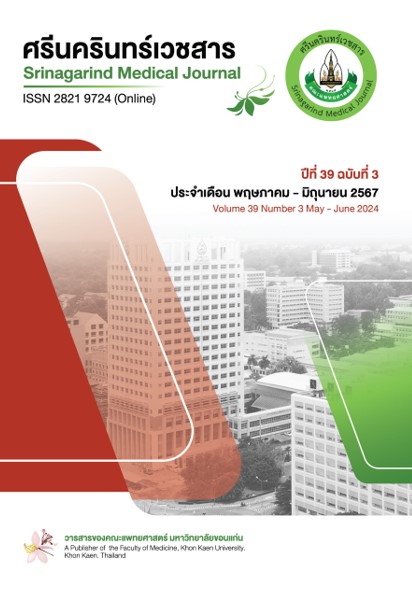Pregnant Outcomes, Pregnancy Delivery, Risk Factors and Nursing Care in Pregnant Women with Placenta Accreta Spectrum in the Delivery Room Unit, Srinagarind Hospital, Khon Kaen Province, Thailand
Keywords:
placenta accreta spectrum, cesarean section with hysterectomy, Srinagarind HospitalAbstract
Background and Objectives: Placenta accreta spectrum (PAS) was a high risk to pregnant woman and infant. The purposes of this research were to study pregnancy outcomes, childbirth, risk factors and nursing care in pregnant women with placenta accreta spectrum.
Results: A sample of 36 cases detected placenta accreta spectrum before birth (97.23%), detected during placental delivery (2.77%), gestational age at birth more than 34 weeks (52.80%), cesarean section and hysterectomy (91.67%), planned birth (72.24%), neonatal weight 1,001-2,500 grams (75.68%), neonatal resuscitation (68.86%), infants transferred to neonatal intensive care unit (56.76%). Risk factors include the number of pregnancies, cesarean section, curettage, miscarriage, and placental abruption. Pregnant women were cared according to the practice guidelines.
Conclusion: Pregnant women who were detected with PAS before birth underwent a cesarean section and hysterectomy. Most were premature births, neonatal resuscitation, infants transferred to neonatal intensive care unit. Risk factors include the number of pregnancies, cesarean section, curettage, miscarriage, and placental abruption. Pregnant women were cared according to the practice guidelines.
References
The American College of Obstetricians and Gynecologists. Placenta accreta spectrum. [Internet]. 2018 [cited Jan 17, 2021] Available from: https://www.acog.org/clinical/clinical-guidance/obstetric-care-consensus/articles/2018/12/placenta-accreta-spectrum.
Jauniaux E, Collins S, Burton GJ. Placenta accreta spectrum: pathophysiology and evidence-based anatomy for prenatal ultrasound imaging. Am J Obstet Gynecol 2018;218(1):75-87. doi:10.1016/j.ajog.2017.05.067.
Ornaghi S, Maraschini A, Donati S, Regional Obstetric Surveillance System Working Group. Characteristics and outcomes of regnant women with placenta accreta spectrum in Italy: a prospective population-based cohort study. PloS One 2021;16(6):e0252654. doi:10.1371/journal.pone.0252654.
Jauniaux E, Bunce C, Gronbeck L, Langhoff-Roos J. Prevalence and main outcomes of placenta accreta spectrum: a systematic review and meta-analysis. Am J Obst Gynecol2019;221(3):208–18. doi.org/10.1016/j.ajog.2019.01.233.
Jauniaux E, Chantraine F, Silver RM, Langhoff-Roos J, FIGO Placenta Accreta Diagnosis and Management Expert Consensus Panel. FIGO consensus guidelines on placenta accreta spectrum disorders: epidemiology. Int J Gynaecol Obstet 2018;140(3):265–73. doi.10.1002/ijgo.12407.
Delivery room, Obstetrics and Gynecological Nursing Department, Srinagarind Hospital. Delivery room statistics for the year, 2022.
Clark SL, Koonings PP, Phelan JP. Placenta previa/accreta and prior cesarean section. Obstet Gynecol 1985;66(1):89-92.
Pegu B, Thiagaraju C, Nayak D, Subbaiah M. Placenta accreta spectrum-a catastrophic situation in obstetrics. Obstet Gynecol Sci 2021;64(3):239-47. doi:10.5468/ogs.20345.
Jauniaux E, Bhide A. Prenatal ultrasound diagnosis and outcome of placenta previa accreta after cesarean delivery: a systematic review and meta-analysis. Am J Obstet Gynecol 2017;217(1):27-36. doi:10.1016/j.ajog.2017.02.050
Bailit JL, Grobman WA, Rice MM, Reddy UM, Wapner RJ, Varner MW, et al. Morbidly adherent placenta treatments and outcomes. Obstet Gynecol 2015;125(3):683-9. doi:10.1097/AOG.0000000000000680
Reale SC, Farber MK. Management of patients with suspected placenta accrete spectrum. BJA Educ 2022;22(2):43-51. doi:10.1016/j.bjae.2021.10.002
Alanwar A, Al-Sayed HM, Ibrahim AM, Elkotb AM, Abdelshafy A, Abdelhadi R, et al. Urinary tract injuries during cesarean section in patients with morbid placental adherence: retrospective cohort study. J Matern Fetal Neonatal Med 2019;32(9):1461–7. doi: 10.1080/14767058.2017.1408069
Delivery room, Obstetrics and Gynecological Nursing Department, Srinagarind Hospital. Delivery room statistics for the year, 2023.
Delivery room, Obstetrics and Gynecological Nursing Department, Srinagarind Hospital. Delivery room statistics for the year, 2014.
Saksangawong S. Case report an undiagnosed of placenta accrete presenting as a massive bleeding in obstetric emergency. Royal Thai Army Med J 2018;71(3):215-22.
Committee on Pactice Bulletins-Obstetrics. Practice bulletin no. 183: postpartum hemorrhage. Obstet Gynecol 2017;130(4):e168. doi:10.1097/AOG.0000000000002351.
Cunningham FG, William M. Obstetrics, 25th ed. United state: McGraw-hill Education; 2018.
Gelany SE, Mosbeh MH, Ibrahim EM, Mohammed M, Khalifa EM, Abdelhakium AK, et al.
Placenta accreta spectrum (PAS) disorders: incidence, risk factors and outcomes of different management strategies in a tertiary referral hospital in Minia, Egypt: a prospective study. BMC Pregnancy Childbirth 2019;19(1):313. doi:10.1186/s12884-019-2466-5
Tadayon M, Javadifar N, Dastoorpoor M, Shahbazian N. Frequency, risk factors, and pregnancy outcomes in cases with placenta accreta spectrum disorder: a case-control study. J Reprod Infertil 2022;23(4):279-87. doi:10.18502/jri.v23i4.10814
Downloads
Published
How to Cite
Issue
Section
License
Copyright (c) 2024 Srinagarind Medical Journal

This work is licensed under a Creative Commons Attribution-NonCommercial-NoDerivatives 4.0 International License.




